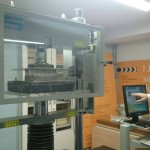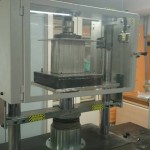La semana pasada se realizó el ensayo cuasiestático del Impact Attenuator. Debido a que este año el equipo va a dar un gran salto pasando de chasis tubular a monocasco, el acoplamiento de este elemento al monoplaza es distinto al del año pasado, y hay que validar el diseño.
El Impact Attenuator del FSB2014 era de espuma, este material absorbe mucha energía y los esfuerzos recibidos en el impacto se distribuyen uniformemente en la base, es decir, en la placa anti-intrusión. Está placa era de acero de 1,5mm de espesor e iba soldada a la parte frontal del chasis.
En el FSB2015 hemos apostado por un Impact Attenuator de panel de abeja de aluminio (Aluminium honeycomb). Un material que absorbe más energía que la espuma y es más ligero, pero que tiene el inconveniente de transmitir los esfuerzos en una sección más reducida debido a que tiene menos sección en la base. Es decir, la base no ocupa toda la placa, factor por el cual no pudimos implementarlo el año pasado. Respecto a la placa anti-intrusión este año será de aluminio de 4mm de espesor, ya que irá atornillada a la parte frontal del monocasco, tiene mayor rigidez a flexión que la de acero y es un poco más ligera.
El ensayo cuasiestático salió según lo previsto. Analizamos el comportamiento del material, la energía absorbida por deformación y a que tensión empieza a comprimirse. Estudiamos también el comportamiento de la placa anti-intrusión obteniendo unos resultados muy favorables a la hora de plantear el ensayo dinámico. El Impact Attenuator se deformó plásticamente en su totalidad. Sin embargo, la placa se deformó en régimen elástico, y al retirar la carga recuperó prácticamente su forma original.
Por lo tanto, el próximo paso es realizar un ensayo dinámico y comprobar que la placa anti-intrusión no se deforma permanentemente más de 25,4mm después del impacto de 300kg a 7m/s.
Last week the quasi-static test of the Impact Attenuator was performed. Due to the great leap forward that the team will make this year, changing from a tubular chassis to a carbon fiber monocoque, this test was critic. The reason is that the joint is different from the one of the last year.
The Impact Attenuator of the FSB2014 was made of foam, since it absorbs a great amount of energy and all the received efforts are evenly distributed through the base, through the anti-intrusion plate. This plate was made of 1.5 mm steel and was welded to the front of the chassis.
In the FSB2015 we have selected an aluminum honeycomb Impact Attenuator, because it absorbs more energy and it is lighter than the foam. However, as a disadvantage we can underline that it transmits forces through a lower section since its base is smaller. That is, the plate is bigger than the base, reason why we could not use it last year. Regarding the anti-intrusion plate of this year, it will be made with a 4 mm thick aluminum, as it will be bolted to the front of the monocoque, has a greater flexural stiffness and is a little bit lighter than the steel.
The quasi-static test went as planned. We analyzed the behavior of the material, the energy absorbed by the deformation and the tension at which it begins to compress. We also studied the behavior of the anti-intrusion plate and we got very positive results regarding the dynamic test. The Impact Attenuator was deformed plastically, but the plate deformed elastically, and after removing the load it recovered its natural shape.
Therefore, the next step is the dynamic test and the verification that the anti-intrusion plate will not be permanently deformed more than 25.4 mm after the impact of 300kg to 7m/s.


